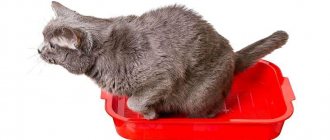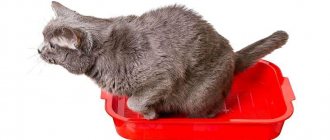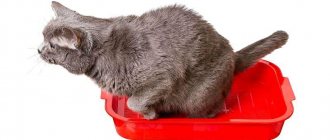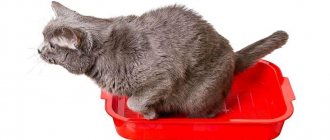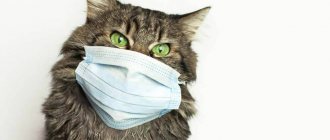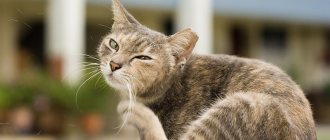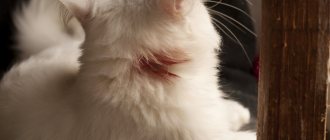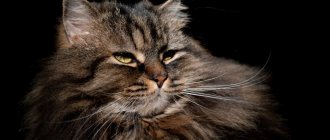The process of peeling off the top layer of keratinized skin occurs constantly, due to the renewal of the epidermis. Excessive accumulation of “scales” on the skin of an animal is called dandruff. Dandruff is a symptom of a pathological condition caused by disruption of the sebaceous glands and characterized by an increase in the rate of detachment of skin particles in the form of scales over a long period of time. The scientific name of this disease is seborrhea. It affects kittens and adult cats of all breeds, regardless of gender.
In the article we will tell you why dandruff appears, what to do when it is detected, how to cure seborrhea by going to the doctor and at home, as well as possible complications of the disease and preventive measures.
Main features
Signs of seborrhea in a cat:
- excessively oily skin under the coat;
- excessive amount of white “scales” of keratinized skin;
- inflammation (redness) of the skin;
- presence of itching.
There are three types of seborrhea:
- dry: “scales” of skin fall off when stroking the fur;
- oily: dandruff does not fall off when combed, the “scales” are glued together;
- mixed type.
Causes of dandruff
There are external and internal causes of the disease.
External ones include:
- Low level of air humidity. Dry air negatively affects the skin of the animal, the skin becomes thick and dry, and dandruff appears. Often accompanied by the appearance of cracks on the paw pads.
- Lack of proper care for the cat's fur and its place of residence, unsanitary conditions. In this regard, fleas, lice and other parasites appear and actively reproduce, causing irritation and itching of the skin. Dandruff can be caused by mites if the animal walks outside.
- The effects of cosmetics and cleaning products on animal fur.
Important! Using shampoo intended for humans may cause allergic reactions on your pet's skin.
- Improper combing of fur. Leads to irritation, scratches and microtraumas of the animal’s skin, which leads to accelerated skin regeneration and the appearance of “scales”.
- Sunburn or excess ultraviolet rays. They lead to accelerated death of epidermal cells and, accordingly, the appearance of dandruff.
- Stressful situations. For example: sterilization, moving to a new place, bringing another pet or child into the house.
- Frequent contact with water. Constant wetting of the skin causes irritation and drying out of the upper layer of the epidermis.
Internal factors:
- Incorrectly formulated diet. It entails a lot of health problems, such as:
- Obesity. If an animal is overweight, it is difficult to care for itself, reaching the back and lumbar area, which is why excess dandruff accumulates in these places.
- Allergic reactions.
Carefully! Allergies can be caused not only by food, but also by chemicals in finished food.
- Problems with the digestive system. They lead to metabolic disorders in the body, which affects the appearance of the cat.
- Vitamin deficiency or excess vitamins. For example, when there is a lack of vitamins A and B in the body, or when there is an excess of them, seborrhea appears.
- Bacterial or fungal diseases. For example, microsporia or lichen lead to skin irritation, constant itching and hair loss in the affected areas.
- Hormonal disorders (hypothyroidism, sex hormone imbalance, Cushing's syndrome). Disturbed metabolism associated with the functioning of the thyroid gland leads to seborrhea.
- Diseases of the musculoskeletal system (arthritis, arthrosis). Pain in the joints when moving prevents the cat from grooming the rump and tail areas, which leads to excessive deposits of “scales” on the skin in these areas.
- Diabetes. A disease associated with insufficient production of the hormone insulin and leading to metabolic disorders, which also affects the animal’s skin.
- Diseases of the urinary system.
- Seborrhea of idiopathic form. This is a hereditary disease characterized by the active secretion of sebum.
- Side effect from drug treatment. Skin reactions occur to medicated shampoo or to taking medications.
How to treat dandruff in cats
Treatment of dandruff in cats is carried out comprehensively and necessarily involves compliance with hygiene rules. The owner of a furry pet will have to not only provide it with medications, but also carry out a general cleaning of the room, monitor its behavior so that there is no hypothermia, overheating, contact with foreign animals, and so on.
Therapeutic measures include:
- drug treatment of the underlying disease, if it has been identified;
- taking antihistamines to relieve itching;
- taking vitamins;
- use of medicinal detergents;
- traditional methods;
- diet therapy (especially if you are overweight and have allergic dandruff);
- massage that improves blood circulation in the skin.
If the air is extremely dry, it is recommended to install a humidifier or use improvised methods.
Periodic brushing is one of the measures to prevent dandruff in cats.
Drug treatment
Medicines prescribed for the treatment of dandruff in patients with mustaches may belong to different groups. In case of inflammatory processes on the skin (dermatitis) or their high risk, the doctor will prescribe anti-inflammatory drugs, and in case of itching - antihistamines. Depending on the disease that provoked seborrhea, the following groups of medications may be prescribed:
- anthelmintics;
- antifungal;
- hormonal;
- antibacterial.
If the reason lies not in an internal disorder, but in an external factor, then, as a rule, they limit themselves to diet, folk methods and a change in hygiene products.
Vitamins for dandruff
The veterinary pharmacy today offers a huge selection of vitamin and mineral complexes that help restore the cat’s metabolism and appearance. Some of them are aimed at activating hair growth (Sherstevit), others have an antiallergic effect (for example, Veda). There are complexes that normalize the functioning of the sebaceous glands, affecting metabolic processes in general (Farmavit-neo). Taking vitamins is an essential part of treating dandruff, regardless of its cause.
Medicinal shampoos
Medicated shampoos will help rid your cat of severe dandruff. When choosing, you need to pay attention to the composition. They usually contain the following components.
Component
Action
Chlorhexidine
Antiseptic, antibacterial action.
Salicylic acid
Promotes faster rejection of dead skin particles. Has a healing effect.
Zinc
Has a healing effect. Stimulates the restoration of the epidermis.
Burr oil
It has anti-inflammatory, regenerating, hair growth stimulating effects. Softens the skin.
Plant extracts
They have a variety of therapeutic effects on hair and skin.
The most popular shampoos at the moment are: Fiprex (for external parasites), Doctor (antiseborrheic, destroys fungus), Biovax (normalizes the activity of the sebaceous glands).
Important: the therapeutic hygiene product must match the type of dandruff the cat has. Otherwise, complications may occur.
Traditional methods
Medicinal shampoos have proven themselves against dandruff
When choosing one or another traditional method of treatment, you also need to consider what type of dandruff a cat develops. For example, with dry dandruff, lactic acid, urea, and oils are used to wash the animal. If the scales are oily, drying agents are used: salicylic acid, vinegar, preparations with sulfur. In any case, rubbing oils (burdock, olives, calendula) into the hair and skin gives a good effect, since at the same time the skin is massaged, blood flow is improved, and the epidermis is cleansed.
Wool can be wiped with decoctions of medicinal plants. Often used are infusions of calendula or string, burdock, and oat decoction. Such rubbing can be done every other day. Pouring or bathing in herbal decoctions can be done once every 1-2 months. You can combine washing with a medicated shampoo and rinsing the wool with a herbal solution.
Types of dandruff
Dandruff is distinguished by color and location:
- By color:
- Yellow-white (grains or flakes) is localized on the back and other areas due to allergies, sunburn or malfunction of internal organs.
Black impurities in dandruff
- Black flecks in the fur along with dandruff can be a sign of fungal infections or the presence of parasites.
- By localization:
- On the back, in the area of the tail and lower back, symptoms of seborrhea most often appear due to fungal diseases (for example, microsporia, dermatomycosis), worms, sunburn, or due to the animal being overweight. Diseases of the musculoskeletal system can also affect this, preventing the cat from fully carrying out independent hygiene procedures.
- The “wandering” nature of seborrhea indicates the presence of parasites in the body, for example, subcutaneous mites. It may also be accompanied by baldness in certain areas of the skin, which is one of the symptoms of lichen or adenitis.
Symptoms
Dry seborrhea is microparticles of skin that cover the entire body of the pet. By stroking it against the grain, the dandruff comes off and swirls around like dust.
The symptoms are:
- - keratinization of the skin,
- - insufficient function of the glands responsible for the production of sebum;
- -dryness of the epidermis and its peeling.
What should an owner do if he is faced with intense dandruff formation in a cat? First, treatment must be prescribed by a veterinarian. At the hospital you will certainly be asked about food, hygiene products, living conditions, and previous diseases. Afterwards, it is necessary to prescribe blood tests, biopsies, and take material from the surface of the epidermis. It is possible to conduct research on a cultural species in a nutrient medium. If the tests show the presence of a pathological picture in the pet’s body, the veterinarian will prescribe a subsequent examination.
Buy medicine for Dandruff =>>
How to prevent seborrhea
Try to help your pet get rid of the disease yourself using the following methods:
- carry out antiparasitic treatment at home;
- check the air humidity level, you may need a humidifier;
Bathing a cat to treat dandruff
- examine the animal’s fur for the presence of fleas and ticks, if necessary, use a special shampoo or spray to get rid of them;
- study the composition of your cat’s diet for foods that can cause allergies or digestive problems;
- evaluate the appearance of the animal, it may be obese, and it is necessary to adjust the diet and diet;
- do not wash your pet more than once every 2 months; when washing, use only shampoo intended for this purpose and not too hot water;
- check the composition of household chemicals used when cleaning the house; you may have to change the products to less allergenic ones.
Important! If after carrying out all the above measures the disease progresses, contact your veterinarian.
Prepare in advance the answers to the questions that the doctor will ask you at the appointment to make the correct diagnosis. List of sample questions:
- What is the cat’s diet (main products, diet, amount of food).
- Basic habits and behavioral characteristics of the pet (for example, does it like to lie in the sun, which can cause sunburn).
- How well are hygiene rules observed at home?
- What products and how often do you use when bathing your pet and cleaning the house?
- What vitamin supplements do you give?
- Where and in what conditions does the cat live?
- What was or is you sick with? What medications were used for treatment.
- How do you care for your fur?
After collecting anamnesis, the doctor will prescribe the following tests:
- general blood test and biochemistry;
- blood test for hormones;
- skin scraping;
- inoculation on a nutrient medium and identification of skin culture;
- skin biopsy.
Diagnostics
During the consultation, the specialist will definitely clarify how long ago dandruff was discovered, if there are other symptoms, and what foods make up the animal’s daily diet. All this is not idle curiosity. The most detailed story from the cat owner will help the veterinarian determine the cause of the disease. In more complex cases, diagnostic tests may be required. For example:
- General blood test, urine test and biochemistry;
- skin scraping to identify mites or ringworm;
- T3 and T4 tests to check the level of thyroid hormones in the blood;
- allergic reaction test. In this case, the animal is given subcutaneous samples containing a small amount of allergens (pollen, dust, etc.).
Treatment of seborrhea
Treatment of seborrhea is prescribed comprehensively, it includes:
- prescription of medications;
- changing the diet and composition of food;
- prescription of vitamins (Sherstevit, Phytomins VEDA, Farmavit NEO, Beaphar and others) and food additives containing Omega-3 fatty acids;
- prescribing a course of antifungal therapy and antibiotics for fungal and bacterial infections, as well as retinoids;
- improving the sanitary condition of the room where the cat lives;
- changing the care of the animal's fur;
- use of medicated shampoos;
- use of folk remedies;
- skin massage and proper combing of the coat.
Carefully! At home, treatment of seborrhea can be carried out after consulting a doctor, prescribing special detergents and permission to use traditional medicine.
Effective shampoos for seborrhea include:
- Antifungal and antiseborrheic: “Doctor”, “Veterinary Formula Clinical Care”, “Tea Tree”, SynergyLabs Veterinary Formula Antiseptic & Antifungal, Anju Beauté.
- For fleas and parasites: “Clandestine”, “Bayer Adventage 80”, “Beaphar”, “Fiprex”.
- For ectoparasites: "Lufenuron Oral Suspension For Cats".
- To normalize the functioning of the sebaceous glands: “Biovax”
Such shampoos, in a certain dosage, contain substances that can fight the disease and its consequences, for example:
- chlorhexine (antibacterial effect);
- zinc (skin regeneration and healing);
- salicylic acid (exfoliation of dead epithelial cells, healing of the skin);
- vinegar (fights infections, has an antibacterial effect);
- olive, burdock or calendula oils (promote softening and renewal);
- herbs: string, chamomile, burdock (relieves itching, irritation, restores epithelium).
It is dangerous to practice many of these ingredients on your own to treat seborrhea without consulting your doctor; you need to know the correct dosage, frequency and duration of their use.
Treatment at home
There are traditional medicine remedies and recipes that your doctor will most likely allow you to use to fight the disease at home:
- Bathing the pet once every 2 months with a special shampoo, massaging the skin and combing the skin during the procedure. Actions during and after washing: for dry seborrhea, use moisturizers in the form of oils added to water (urea, propylene glycol, sodium lactate, lactic acid);
- in case of oily seborrhea, in case of severe course and complications of the disease with dermatitis, remove the hair from the pet’s skin, then use bandages with ethyl alcohol for disinfection, treat the skin with Engystol to eliminate inflammation and itching. In addition, for this type of disease, products are used that degrease and dry excessively oily skin (sulfur compounds 0.5-2%, salicylic acid 0.5-2%, selenium sulfide, benzoyl peroxide).
- series;
What type of dandruff does cats have?
There are 3 types of dandruff in felines.
- Dry. It can be shaken off your hands and fur. Gives the animal's hair a dry, dull appearance.
- Fat. May have different thickness. Thus, the “liquid” version is manifested by a pronounced greasiness of the hairs, which are glued together. If you stroke the animal, excess secretion will remain on the palm. With increased density of dandruff (less sebaceous secretion and more skin flakes), it remains in large quantities under the owner’s nails when trying to scratch the pet.
- Mixed. The death of skin cells and the work of the sebaceous glands occur unevenly on the surface of the animal’s body, which leads to alternating dry and oily seborrhea.
Complications
Complications of seborrhea may be the following:
- Purulent dermatitis. Occurs in the area affected by seborrhea due to the layering of bacterial flora, usually located on the upper layer of the epithelium and does not cause reactions. Ulcerations form, itching intensifies, and the skin becomes very red.
- Eczema. Redness and itching of the affected area after scratching becomes covered with papules (nodules), in place of which vesicles (bubbles) with liquid appear. Pyogenic bacteria enter places with opened blisters, the wounds become infected and ulcers, ulcers and erosions appear. The skin is constantly inflamed, swollen, raw, and the animal is in pain.
Why is dandruff dangerous for cats?
Neglected dandruff can lead to complications. One of them is hair loss, up to complete or local baldness. It happens that such places are difficult or impossible to restore in the future. Hair loss occurs due to the fact that dandruff accumulations interfere with gas exchange in the skin, causing disruption of metabolic processes and weakening of hair follicles.
Another complication is purulent inflammation of the skin, reaching the deep layers. The accumulation of dead epidermis serves as an excellent breeding ground for the proliferation of pathogenic microorganisms. Normally, they live on healthy skin, but cannot cause harm due to the good functioning of local immunity. With seborrhea, the immune system weakens, microbes multiply, redness, irritation, and itching occur. As a result of scratching, the infection penetrates even deeper - ulcers, pus, and eczema appear.
Prevention
Disease prevention measures include:
- Ventilate the room and provide sufficient air humidification.
Omega-3 fats to prevent dandruff
- Controlling the cat's prolonged stay near heating devices.
- Careful selection of hair care products, litter and bedding to avoid allergic reactions.
- Regular procedures for massaging the skin and combing the coat with a special comb or brush.
- Cat's access to clean drinking water.
- Bathing no more than once every 2 months with a properly selected preventive shampoo, monitoring the water temperature.
- Balanced and nutritious nutrition with regular monitoring of the cat’s weight.
- Vitamins and nutritional supplements containing omega-3 fatty acids.
- Regular inspection and ridding of your pet of fleas, ticks and other parasites.
- Monitoring the amount of time your animal spends in direct sunlight to avoid sunburn.
- Avoid stressful situations whenever possible.
- Using the services of a groomer for professional care of an animal's fur and skin with medicinal cosmetics approximately once every 2 months.
To avoid serious consequences for your pet’s health, carefully monitor its condition and lifestyle, provide proper care and optimal living conditions, and do not neglect contacting an experienced veterinarian at the slightest sign of illness.
